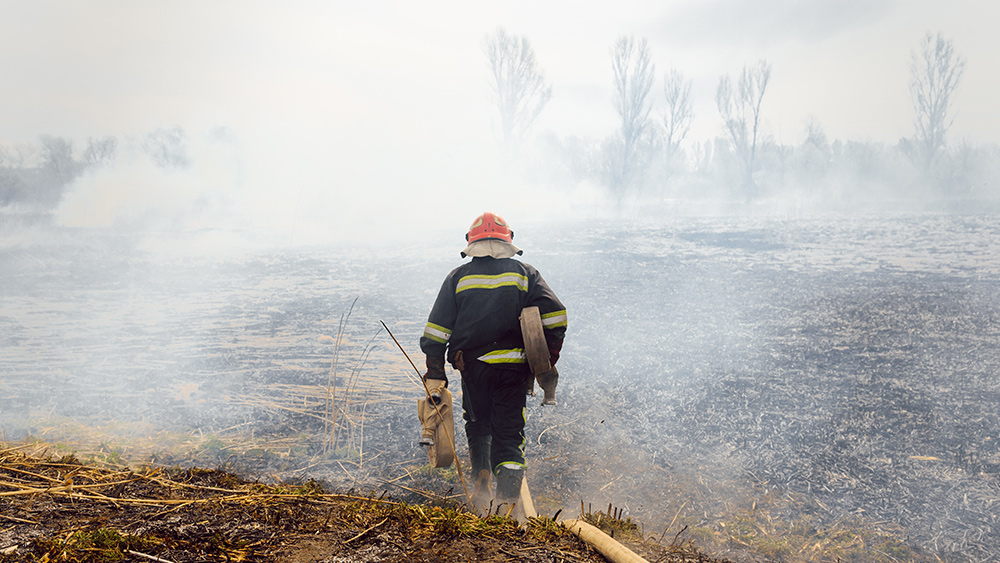Lost 5,000-year-old civilization uncovered beneath Arabian sands
05/23/2025 / By Lance D Johnson

For centuries, the Rub’ al-Khali — the vast “Empty Quarter” of the Arabian Peninsula — was dismissed as a barren wasteland, a lifeless expanse of shifting dunes. But beneath its surface, hidden in plain sight, lay the remnants of a forgotten civilization, now being unearthed thanks to cutting-edge technology. The discovery of Saruq Al-Hadid, a 5,000-year-old metallurgical hub, challenges long-held assumptions about the region’s history and raises tantalizing questions about the fate of the legendary “Atlantis of the Sands.” This revelation, made possible by satellite imaging and artificial intelligence, exposes how mainstream archaeology has overlooked entire chapters of human ingenuity — until now.
Key points:
- A lost civilization, dating back 5,000 years, has been discovered beneath the Rub’ al-Khali desert in the United Arab Emirates.
- Advanced radar and AI technology revealed buried structures, metal artifacts, and evidence of organized society.
- The site, Saruq Al-Hadid, may be linked to the mythical city of Ubar, long thought to be a legend.
- Researchers suggest the region was once far more habitable, with lakes and thriving ecosystems.
- The discovery challenges conventional narratives about early human settlements in the Arabian Peninsula.
The myth becomes reality: Uncovering the “Atlantis of the Sands”
For generations, the legend of Ubar — a wealthy city swallowed by the desert as divine punishment — was dismissed as mere folklore. T.E. Lawrence, the famed British officer, immortalized it as the “Atlantis of the Sands,” a cautionary tale of human arrogance. But in 2002, Sheikh Mohammed bin Rashid Al Maktoum, ruler of Dubai, noticed strange formations from the air, sparking an investigation that would rewrite history.
Using Synthetic Aperture Radar (SAR), researchers from Khalifa University penetrated the desert’s surface, revealing hidden structures, metalworking remnants, and layers of animal bones. “We needed equipment that could look under the sand,” said Dr. Diana Francis, head of the ENGEOS Lab. “Satellite imagery was crucial.”
The findings suggest a sophisticated society engaged in copper and iron smelting, with roadways and settlements indicating long-term habitation. Could this be the real Ubar? While definitive proof remains elusive, the evidence aligns eerily with ancient accounts of a prosperous city lost to time.
How technology is rewriting history
Traditional archaeology often relies on painstaking excavation, but in harsh environments like the Rub’ al-Khali, digging is nearly impossible. SAR technology, combined with AI, changes the game. By analyzing radar reflections, researchers identified patterns invisible to the naked eye, uncovering entire networks of human activity beneath the dunes.
“The case study of Saruq Al-Hadid illustrates the potential of these technologies to enhance archaeological surveys,” the research team noted. This breakthrough isn’t just about uncovering artifacts — it’s about exposing how much of human history has been obscured by environmental shifts, bias, and institutional oversight.
A once-thriving land, now buried in sand
Today, the Rub’ al-Khali is one of the most inhospitable places on Earth. But 5,000 years ago, it was a different world. Geological evidence suggests the region experienced periods of heavy rainfall, creating shallow lakes and supporting diverse ecosystems. Nomadic tribes, early metallurgists, and traders may have flourished here before climate shifts turned the land to desert.
The discovery of Saruq Al-Hadid forces a reevaluation of early Arabian civilizations. Were these people part of a larger, interconnected network? Did they trade with Mesopotamia or the Indus Valley? The answers may lie beneath the next layer of sand—waiting for technology to reveal them.
As the Empty Quarter slowly gives up its secrets, one thing is clear: history is far more complex than we’ve been led to believe. And with each new discovery, the old narratives crumble like ancient ruins beneath the weight of truth.
Sources include:
Submit a correction >>
Tagged Under:
AI technology, ancient history, ancient metallurgy, Archaeology, Atlantis of the Sands, desert discoveries, Dubai archaeology, forgotten societies, hidden cities, Khalifa University, lost civilization, research, Rub al Khali, Saruq Al-Hadid, synthetic aperture radar, T.E. Lawrence, truth in history, UAE history, Ubar
This article may contain statements that reflect the opinion of the author




















